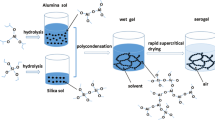Abstract
The α-AI2O3 transformation of a monolithic active alumina has been increased from 1200 to ∼1380‡ C through structural incorporation of silica. This shift is significant since α-Al2O3 transformation determines the limits of the usefulness of these materials as catalysts and catalyst carriers. The thermal stabilization effect is optimized at around 6% silica doping. At elevated temperatures, the material containing no silica rapidly loses surface area, primarily by α-Al2O3 transformation, whereas the material containing excess silica loses surface area by classical sintering.
Similar content being viewed by others
References
S. M. Fridman, Tresta Organizatsii i Ratsional Elektronstansii, 9 (1954) 37; Referat. Zhur. Khim. (1956) Abstr. No. 48123.
J. C. Greaves and J. W. Linnett, Trans Faraday Soc. 54 (1958) 1323.
A. W. Miller and S. W. Roberts, Ind. Chem. 34 (1958) 141.
Alcoa Brochure, “Activated and Catalytic Aluminas” June 1 (1970).
W. H. Gitzen, “Alumina as a ceramic material”, The American Ceramic Society, Inc. Special Publication No. 4 (1970).
G. C. Bye and G. T. Simpkin, J. Amer. Ceram. Soc. 57 (1974) 367.
Y. Wakao and T. Hibino, Nagoya Kogyo Gijutsu Shikensho Hokoku 11 (1962) 588.
S. Mukherjee and H. Roy, Technology 3 (1966) 63.
M. D. Efros et al., Vetsi Akad. Nauk Belarus. SSR Ser. Khim. Nauk. 1 (1971) 9.
G. Fink, Natur. 52 (1965) 32.
S. E. Voltz et al., U.S. Patent 2,810,698, October 22 (1957).
Idem, U.S. Patent 2,810,699, October 22 (1957).
R. K. Iller, J. Amer. Ceram. Soc. 47 (1964) 339.
W. H. Gitzen and L. D. Hart, U.S. Patent 3,433, 894, May 13 (1969).
Idem, U.S. Patent 3,433,895, May 13 (1969).
B. E. Yoldas, Amer. Ceram. Soc. Bull. 54 (1975) 286.
Idem, J. Appl. Chem. Biotech. 23 (1973) 803.
Idem, Bull. Amer. Ceram. Soc. 54 (1975) 289.
Idem, “Methods of Forming Porous Transparent Alumina-Based Ceramics”, Presentation at the Ceramic Society 77th Annual Meeting, Washington, D.C., May (1975).
Idem, J. Mater. Sci. 10 (1975) 1856.
Guy Ervin, nJun., Acta Crust. 5 (1952) 103.
Robert Tertain, Denis Papee and Jacques Charrier, Compt. Rend. 238 (1954) 98.
H. P. Rooksby, J. Appl. Chem. 8 (1958) 44.
H. P. Rooksby and C. J. M. Rooymans, Clay Miner. Bull. 4 (1961) 234.
Author information
Authors and Affiliations
Rights and permissions
About this article
Cite this article
Yoldas, B.E. Thermal stabilization of an active alumina and effect of dopants on the surface area. J Mater Sci 11, 465–470 (1976). https://doi.org/10.1007/BF00540927
Received:
Accepted:
Issue Date:
DOI: https://doi.org/10.1007/BF00540927




